Pantera 2025 Outlook: How will the on-chainization of the US dollar reshape the global financial landscape?
Original title: The Year Ahead In Crypto
Original author: Pantera Capital
Оригинальный перевод: zhouzhou, BlockBeats
Примечание редакции: This article focuses on how blockchain technology, especially stablecoins and asset tokenization, is strengthening the global dominance of the US dollar. The United States is advancing stablecoin legislation, which is expected to make progress in 2025. The tokenization of real-world assets has promoted the development of DeFi, allowing traditional assets to gradually integrate into the blockchain, and will continue to enhance the importance of the US dollar in the global financial system.
Ниже приводится исходное содержание (для удобства чтения и понимания исходное содержание было реорганизовано):
The next 100x opportunity for blockchain
Author: Franklin Bi, General Partner
What is the path for криптовалютаcurrency to enter the mainstream?
Beyond the noise and speculation, this is the only question that matters. As investors, our job is to chart the path to adoption, because only along that path can we find the next 100x investment opportunity.
But the best venture capitalists don’t predict the future, they see clearly into the present. There is no doubt that 2025 will be a turning point for the cryptocurrency industry.
Imagine if Jeff Bezos was arrested for selling books online; if Steve Jobs was sanctioned for launching the App Store; or if Jensen Huang had to build Nvidia outside the U.S. because his bank account was closed due to Operation Interdiction. This is exactly the “gray area” our industry is moving out of.
2025 is the first time in the history of blockchain that entrepreneurs, regulators, and policymakers finally have the opportunity to open up the path to popularization. Faced with this finally cleared path, we return to the original question: What will be on the road to popularization? Where will the next 100x or even 1,000x investment opportunity appear?
Just as Social/Local/Mobile (SoLoMo) unlocked the potential of the Internet in the 2010s, three trends converging starting in 2025 will unlock the adoption of cryptocurrency:
Entry point – connecting the traditional financial system to the blockchain;
Developers – making it easier to build the Internets native economic layer;
Applications – Creating meaningful applications for everyday life.
Entrance
Wall Street has undergone a software upgrade over the past 50 years, from the introduction of electronic trading in the 1970s to the digitization of payments today. The steady progress of software infiltrating the financial industry has taught us one thing: all financial assets will eventually migrate to where liquidity is freer, trading is more efficient, and value is optimized.
Today, blockchain networks already host $3 trillion in crypto assets (such as Bitcoin, Ethereum, etc.) and a small number of asset-backed tokens (such as tokenized US dollars and Treasury bonds). However, the total amount of financial assets held by households, governments, and companies around the world exceeds $100 trillion (1 quadrillion!), which means that blockchain has the potential to grow 300 times.
Where are we now? The game hasn’t even started yet, and the players are still on the bus. The global balance sheet has just begun to migrate to the blockchain. To succeed, we need an on-ramp from the traditional financial system to the blockchain.
We must expand platforms that can effectively access new users and existing assets. For example, Bitso in Latin America, as a regional gateway, has processed more than 10% of US-Mexico remittances using blockchain. Токенization platforms like Ondo are going head-to-head with Franklin Templeton and BlackRock to bring $20 trillion of US Treasury bonds to the chain.
Cryptocurrencies are enabling truly global capital markets, powered by real-time settlement and borderless liquidity. However, global markets require global trading venues. Обменs like Figure and Avantis are bringing together global supply and demand, transforming the foreign exchange, credit and securities markets simultaneously.
Finally, we need products that are compatible with existing systems, not just a parallel crypto universe. These products may be advanced wallets designed for institutions like Fordefi, or simple and easy-to-use payment solutions for ordinary users like TipLink.
We believe that one day, your net worth will be more valuable on-chain than off-chain. Once migrated to the chain, your wealth can flow around the world instantly, with low-cost transactions, free from middleman fees, and achieve the highest value through global demand. This will be an irreversible inflection point.

Developers
There are currently about 100,000 developers developing on the blockchain, which is only half of a Silicon Valley tech giant. To achieve mainstream adoption, we need to increase this number 100 times and introduce 10 million developers into the blockchain ecosystem.
Unleashing the creative potential of blockchain technology is critical. Just as better tools helped mobile developers unlock the potential of Apple’s App Store, we need tools that simplify building apps and creating new products on the blockchain.
By 2025, the blockchain development tool stack will see a major leap forward. The key is to make the blockchain itself more developer-friendly. Technology like Arbitrums Optimistic Rollup brought the first broadband moment to the crypto space, but upgrades like Arbitrum Stylus may have a greater impact. Stylus allows developers to write smart contracts in a variety of major programming languages such as C, C++, and Rust, giving more than 10 million developers around the world the opportunity to enter the blockchain development field.
Zero-knowledge technology was once seen as too complex to actually develop. But new tools like the StarkWare development kit make it easier than ever to implement zero-knowledge proofs. Today, zero-knowledge proofs are powering products like the Freedom Инструмент, a blockchain voting tool developed by Rarimo that has been used in Russia, Georgia, and Iran to increase democratic participation.
Tools and infrastructure that support blockchain development will play a vital role in driving progress in the industry. Platforms like Alchemy are helping developers build and deploy on-chain applications at scale. By streamlining the development process, Alchemy has helped many projects succeed, ranging from decentralized finance (DeFi) protocols to gaming applications. As the blockchain ecosystem continues to evolve, these developer platforms must keep evolving quickly so that developers can push the boundaries of on-chain development.
The multi-chain universe will continue to grow and may even accelerate through 2025. As developers take on more complex challenges, new blockchains emerge, each with its own strengths in computation, execution, or decentralization. Application-specific infrastructures like B3 are emerging to meet specific use cases like gaming or trading.
This explosive growth of chains, Layer 2, and application chains requires seamless connectivity. Cross-chain liquidity solutions such as Everclear and interoperability protocols such as Omni will liberate developers’ productivity and allow them to focus on building innovative applications.
Web development has evolved from raw coding to intuitive no-code solutions, and now AI is starting to dominate the field. We expect blockchain development to see a similar evolution. Every technological advancement and improvement in developer-oriented tools will attract new waves of talent, and eventually building on-chain applications may be as easy as talking to ChatGPT. 
приложение
How many people are currently using blockchain?
According to most estimates, there are about 80 million on-chain users. Much of the growth comes from the appeal of cryptocurrencies as Wall Street 2.0 – a new place to raise capital, speculate and transfer money. But to achieve 100-fold growth and cover 8 billion people, the key is to move from Wall Street to Main Street.
2025 could be the turning point for mainstream adoption of cryptocurrency, the “FarmVille moment” of blockchain. FarmVille was Facebook’s first social game hit, driving exponential growth in the platform’s users, transforming it from a photo-sharing app into a global platform.
The crypto industry is rapidly heading towards its own “FarmVille moment”. On-chain functionality is being integrated into new games and social applications. Game studios like InfiniGods have attracted a large number of new users through its casual mobile game King of Destiny. The game has been downloaded more than 2 million times in the past year, bringing more users who were playing Candy Crush Saga instead of using Coinbase to the chain.
On-chain games, social networking and collectibles activities account for about 50% of todays active wallets. As more and more users participate in on-chain business activities, blockchain will disrupt society far beyond the financial sector.
A class of productive applications is driving a new industrial revolution, and the era of the company is giving way to the rise of the industrial network. This type of application, also known as DePINs, focuses on underserved markets such as wireless connectivity, hyperlocal data, and human capital. Through on-chain coordination and market-driven mechanisms, projects such as Hivemapper are expanding rapidly. As a decentralized mapping network, Hivemapper has mapped more than 30% of the worlds roads with the efforts of more than 150,000 contributors, and its data is more accurate and real-time than Google Maps.
These productive applications are not only generating revenue, but also opening a new chapter in the blockchain economy. It is expected that by 2025, the annual revenue of the DePIN field will exceed US$500 million in 2024. This industrial-grade cash flow is not only based on actual utility, but also provides a powerful business engine for the on-chain economy, guiding the inflow of new capital.
How to reach 8 billion users? 2025 will witness new distribution models that can reach hundreds of millions of consumers on a large scale. Crypto exchanges such as Coinbase, Kraken and Binance are bringing users on-chain by building their own blockchains. Telegram and Sony are integrating Web3 features into their large user platforms. Game companies are adding on-chain features to classic games such as MapleStory, which may attract millions of players to return. Institutions such as PayPal and BlackRock are also launching on-chain financial and payment solutions.
Through these innovative applications and distribution models, crypto technology is gradually moving into the mainstream and reshaping our understanding of economy and technology.
The convergence of these trends will bring about a critical inflection point in 2025. When the average person has a reason to spend an average of 60 minutes on-chain per week, “being on-chain” will become the new “being online.”
There is no need to rely on killer apps. Just as we switch apps on the Internet, people will spend time on the chain for entertainment, socializing, or making money. By then, the on-chain economy will gradually integrate into our daily lives.
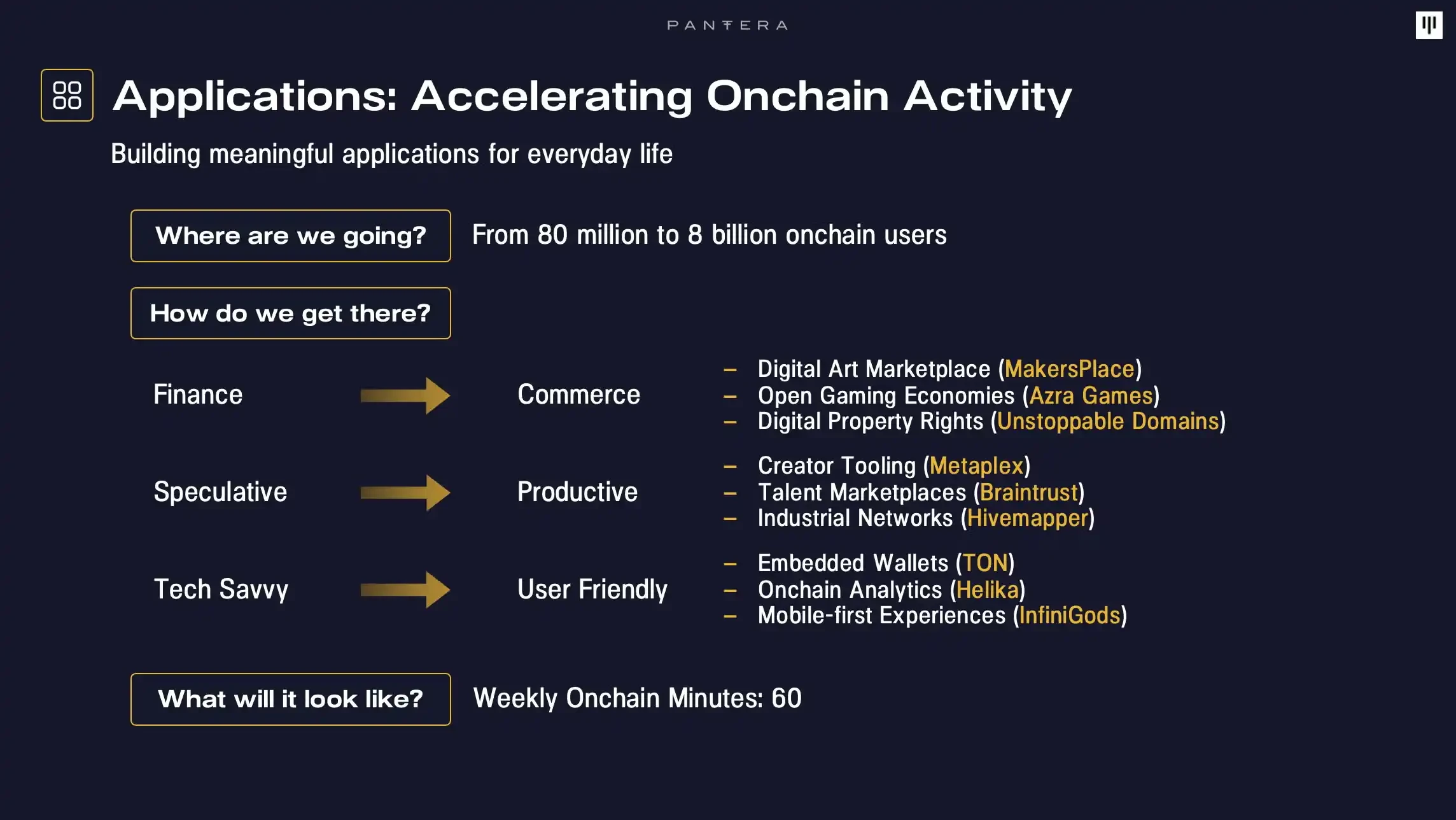
Взгляд вперед
The coming year will usher in an era where blockchain technology begins to become integrated into our daily lives, just as the Internet did. The shift from Wall Street to Main Street is not only happening, it’s accelerating, driven primarily by entertainment, commerce, and real-world applications.
To achieve this, we need to invest in easier on-ramps, improved technology and developer tools, and applications that solve real-world problems. The road to 2025 is still filled with 100x opportunity as mainstream cryptocurrency becomes a reality. As a wise man once said, “The best way to predict the future is to create it.”
Cryptocurrency Predictions for 2025
By Paul Veradittakit, Managing Partner
This year, I enlisted the help of investors from the Pantera team. My predictions fall into two categories: uptrends and new ideas.
Upward Trend
Real-world assets (excluding stablecoins) will account for 30% of on-chain TVL (currently 15%)
On-chain RWAs increased by more than 60% in 2024 to $13.7 billion. About 70% of RWAs are private credit, with most of the rest being U.S. Treasuries and commodities. Inflows into these categories are accelerating, and more sophisticated RWAs are likely to be launched in 2025.
First, private credit is accelerating due to improvements in infrastructure. Figure accounts for almost all of this segment, adding nearly $4 billion in assets in 2024. As more companies enter this space, it will become easier to use private credit to move funds into cryptocurrencies.
Second, there are trillions of dollars of US Treasuries and commodities off-chain. There are only $2.7 billion of US Treasuries on-chain, and their ability to generate yield (unlike stablecoins, which allow issuers to earn interest) makes them a more attractive alternative to stablecoins. Blackrocks BUIDL US Treasury Fund only has $500 million on-chain, while it owns tens of billions of US Treasuries off-chain. Now that DeFi infrastructure has fully accepted stablecoins and US Treasury RWAs (integrating them into DeFi pools, lending markets, and perpetual contracts), it is much easier to adopt these assets, and the same is true for commodities.
Finally, the scope of RWA is currently limited to these basic products. The infrastructure for minting and maintaining the RWA protocol has been greatly simplified, and operators have a better understanding of the risks and appropriate mitigation measures for on-chain operations. There are now dedicated companies managing wallets, minting mechanisms, Sybil awareness, crypto new banks, etc., which means that it may finally be possible to bring stocks, ETFs, bonds, and other more complex financial products to the chain. In 2025, these trends will accelerate the use of RWA.
Bitcoin Finance
Last year, my prediction for Bitcoin Finance was strong but not reaching 1-2% of all Bitcoin TVL. This year, 1% of Bitcoin is expected to participate in Bitcoin Finance, driven by Bitcoin native financial protocols that do not require bridging (such as Babylon), high returns, high Bitcoin prices, and demand for more BTC assets (such as Runes, Ordinals, BRC 20).
Fintech becomes the gateway to cryptocurrency
TON, Venmo, PayPal, and WhatsApp have seen growth in cryptocurrencies because of their neutrality. They are on-ramps where users can interact with cryptocurrencies, but they don’t promote specific applications or protocols; in fact, they serve as simplified on-ramps into cryptocurrencies. They appeal to different user groups: TON serves the existing 950 million Telegram users, Venmo and PayPal serve their respective 500 million payment users, and WhatsApp appeals to its 2.95 billion monthly active users.
Felix is an app that runs on WhatsApp and allows users to transfer money instantly through messages, either digitally or for cash pickup at partner locations such as 7-Eleven. Stablecoins and Stellar-based Bitso are behind it. Users can now buy crypto with Venmo through MetaMask, Stripe acquired Bridge (a stablecoin company), and Robinhood acquired Bitstamp (a cryptocurrency exchange).
Every fintech company will become an on-ramp to cryptocurrency, whether by design or because they can support third-party applications. Fintech companies will become increasingly common and may compete with some smaller centralized exchanges for cryptocurrency holdings.
Unichain Becomes Leading L2 by Transaction Volume
Uniswap has a TVL of nearly $6.5 billion, with 50,000 to 80,000 trades per day and daily volume of $1 billion to $4 billion. Arbitrum has a daily volume of about $1.4 billion (one-third of which comes from Uniswap), and Base has a daily volume of about $1.5 billion (one-quarter of which comes from Uniswap).
If Unichain can capture even half of Uniswap’s volume, it will easily surpass the largest L2 and become the leading L2 by volume.
The resurgence of NFTs, but in an application-specific way
NFTs started out as a tool in cryptocurrencies rather than an end in itself. Now, NFTs are used as tools in on-chain gaming, AI (for trading model ownership), identity, and consumer applications.
Blackbird is a restaurant rewards app that integrates NFTs into customer authentication by connecting an open, liquid and identifiable blockchain to restaurants, providing consumer behavior data and easily creating/minting subscriptions, memberships and discounts for customers.
Sofamon created the Web3 version of Bimoji (or NFT), called Wearables, unlocking the financial layer of the emoji market. They recognize the growing importance of on-chain intellectual property and are fighting digital counterfeiting by partnering with top KOLs and K-pop stars. Story Protocol, which recently raised $80 million at a valuation of $2.25 billion, aims to tokenize the worlds intellectual property, putting originality at the core of creative exploration and creators. Swiss luxury brand IWC has launched a membership NFT that provides access to exclusive communities and events.
NFT can be used for ID transactions, transfers, ownership, and membership, but it can also be used to represent and value assets, leading to monetization and even speculative growth. This flexibility gives NFT huge potential, and its application scenarios will continue to increase.
The launch of Restaking
In 2025, restaking protocols like EigenLayer, Symbiotic, and Karak will finally launch mainnets, paying operators rewards from AVS and penalties. This year, restaking has received less attention.
Restaking protocols gain power through greater network usage. If a protocol uses infrastructure that is powered by a specific restaking protocol, it can gain value from that support, even if it is not direct. It is through this power that protocols can lose relevance but still maintain huge valuations. We believe restaking is still a multi-billion dollar market, and as more applications become appchains, they will leverage restaking protocols or other protocols based on restaking protocols.
zkTLS brings off-chain data to the chain
zkTLS uses zero-knowledge proofs to verify the validity of data from the Web2 world. This new technology is not yet fully implemented, but when it is (hopefully within this year), it will enable new types of data.
For example, zkTLS can be used to prove that data came from a specific website. There is currently no way to do this. This technology leverages advances in TEE and MPC, and may be further improved in the future to allow some data to remain private.
This is a new idea, but we predict that companies will start building this technology and integrating it into on-chain services such as verifiable oracles for non-financial data or cryptographically secure data oracles.
Regulatory support
For the first time, the regulatory environment in the United States appears to be positive about cryptocurrencies. 278 pro-cryptocurrency House candidates were elected, while only 122 were against cryptocurrencies. Anti-cryptocurrency Securities and Exchange Commission (SEC) Chairman Gary Gensler announced that he would resign in January. Trump reportedly plans to nominate Paul Atkins to lead the SEC. He was a former SEC commissioner and publicly supports the cryptocurrency industry and serves as an advisor to the Digital Currency Chamber of Commerce. Trump also nominated David Sacks for the position of AI and Crypto Czar. David Sacks will work to develop a legal framework so that the cryptocurrency industry gets the clarity it has been asking for, Trump said in the announcement.
We hope to see a reduction in SEC litigation, clear definitions of cryptocurrencies as a specific asset class, and tax considerations.
Cryptocurrency: The ironic answer to de-dollarization
Written by: Jeff Lewis, Product Manager, Hedge Funds and Erik Lowe, Head of Content
The growing trend of de-dollarization, which refers to countries and institutions gradually moving away from the dollar’s dominance in global trade and financial transactions, has raised concerns about the dollar’s long-term dominance. The most common measure of the dollar’s dominance is the dollar’s share of foreign exchange reserves, which has fallen 13 percentage points since 2000.
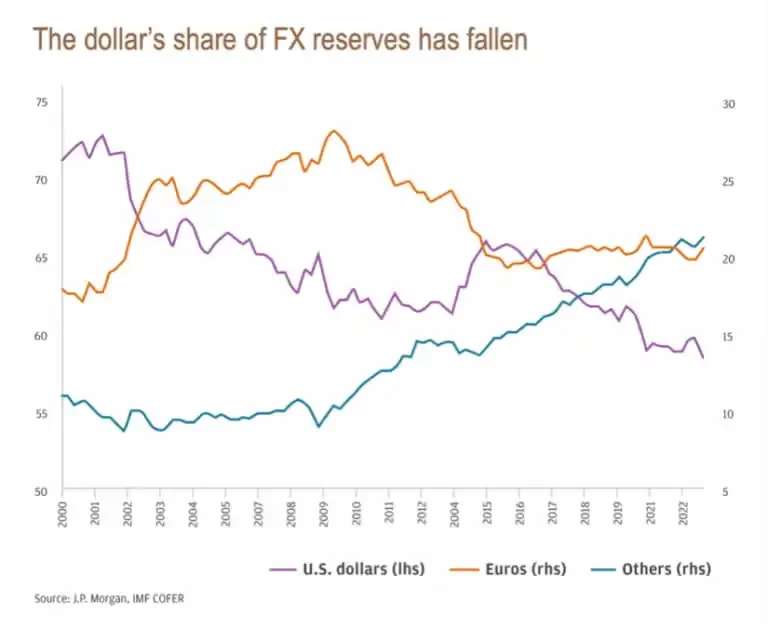
We believe a reversal of this trend is imminent, and ironically, the drivers of this shift are the very factors that most US policymakers and central bankers believed five years ago would accelerate the decline of the dollar: blockchain technology and tokenization. Technologies once seen as potential underminers of the dollar’s status are now positioning themselves as its greatest enablers.
“The most ironic outcome is the most likely outcome.” – Elon Musk
Supercharged Dollar
Public blockchains have supercharged fiat currencies, putting them at the fingertips of the world’s five billion smartphone users and making them easy to move across borders. The demand for tokenized fiat currencies, or stablecoins, has created a $200 billion industry — with the U.S. dollar dominating the market. A report by Castle Island and Brevan Howard included a chart showing the U.S. dollar’s near 100% dominance of stablecoin collateral compared to other economic categories.

Of the top 20 fiat-backed stablecoins, 16 include “USD” in their names. 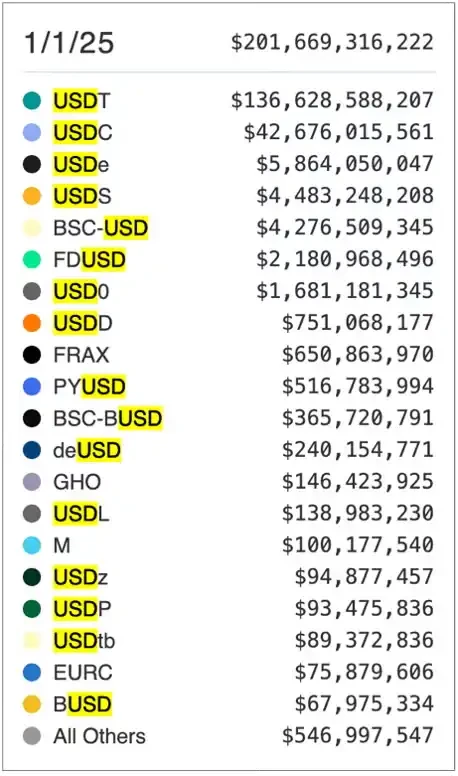
The overall perception of blockchain has changed little over its 16 years of development. Bitcoin’s original proponents did see the potential for the cryptocurrency to challenge the dollar’s dominance. In recent years, Bitcoin has been increasingly viewed as a store of wealth rather than a medium of exchange, which has somewhat reduced its threat to the dollar. The phenomenon of stablecoins and real-world assets has allowed blockchain to fulfill Bitcoin’s original promise by providing a means of exchange that has stability and ultimately generates yield. Rather than weakening the dollar’s relevance, the rise of stablecoins has amplified its role.
Emerging Рынокс
In emerging markets, dollar-backed stablecoins offer a practical alternative to holding cash or relying on fragile banking systems. When consumers and merchants have a choice, countries in unstable monetary environments will increasingly choose the stability of a digital dollar. In their report, Castle Island and Brevan Howard published the results of a survey of existing cryptocurrency users in emerging markets. A key conclusion: dollar-denominated savings are an important factor driving emerging markets.
47% of respondents said their primary purpose for using stablecoins is to save dollars (this is close to the 50% who said they primarily use stablecoins to trade cryptocurrencies or NFTs).
69% of respondents exchange their national currency for stablecoins rather than using them for transactions.
72% of respondents said they expect to increase their use of stablecoins in the future.
Note: Surveyed countries include Nigeria, Indonesia, Türkiye, Brazil and India
Whether the user is a small balance holder or a multinational corporation, the dollar is likely to squeeze out other local currencies as economic actors gravitate toward the safest and most liquid option.
Stablecoin legislation in 2025?
Legislative momentum is building, and stablecoin-focused regulations are expected to be passed during the Trump administration. Patrick McHenry’s Stablecoin Act, originally introduced in 2023 and recently introduced to the House by Rep. Maxine Waters, has bipartisan support. Stablecoin legislation has long been seen as a first step toward regulatory transparency in the United States. We believe we will see important progress in 2025, especially as policymakers become increasingly aware of the strategic role of stablecoins in expanding the influence of the dollar.
Stablecoins are in the best interest of the United States because they will increase the percentage of transactions denominated in dollars and create demand for U.S. Treasury collateral. A country with $37 trillion in debt needs to be distributed, and cryptocurrencies will help with that.
Stablecoins and CBDCs
For the sake of clarity, fiat-backed stablecoins and central bank digital currencies (CBDCs) are two similar but fundamentally different technologies that should not be confused.
JPMorgan Chase published a report on the trend of de-dollarization in October. One potential driver they mentioned is payment autonomy through new technologies. They mentioned projects such as mBridge (a multi-central bank digital currency initiative) as possible alternatives to dollar-based transactions.
While emerging payment systems such as foreign CBDCs have heightened pressure to de-dollarize, we believe the thriving market for dollar-backed stablecoins refutes this argument. We believe that stablecoins built on decentralized, permissionless blockchains will be preferred as they offer better privacy, censorship resistance, and cross-platform interoperability.
Demand for U.S. Treasuries via tokenized products
According to the U.S. Treasury, $120 billion of stablecoin collateral is invested directly in U.S. Treasuries, contributing to increased demand for short-term securities. [3] In addition to stablecoins, direct tokenization of U.S. Treasuries is also a growing trend. Companies like BlackRock through Securitize, Franklin Templeton, Hashnote, and Pantera portfolio company Ondo are leading this $4 billion market.
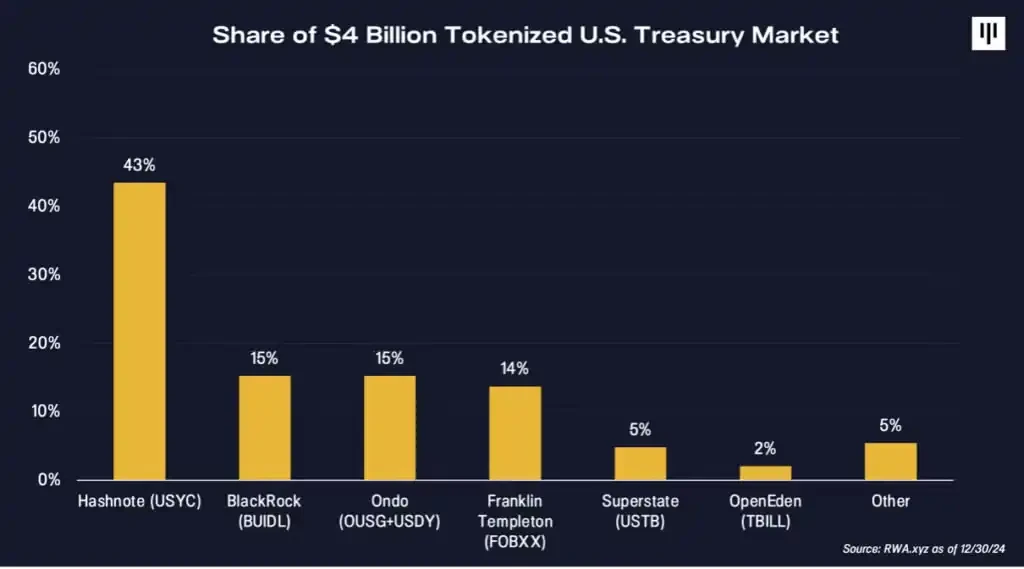
Ondo offers two core products in this space:
USDY (Dollar Yield Token): This is a tokenized note backed by short-term U.S. Treasuries and bank deposits, providing a stable and high-quality yield to non-U.S. investors.
OUSG (Ondo Short-Term U.S. Treasury Bonds): Provides liquid exposure to short-term U.S. Treasury bonds, allowing instant minting and redemption by eligible purchasers.
Products like USDY allow overseas investors to gain access to U.S. dollars and Treasury bonds more easily than through traditional channels.
A new era of dollar dominance
Far from undermining the dollar’s dominance, blockchain technology has created a digital infrastructure that strengthens the dollar’s position. By tokenizing and mobilizing dollar assets globally, the dollar remains indispensable amid geopolitical and technological forces driving pressure to de-dollarize.
As JPMorgan Chase mentioned in its report, the structural factors that support the dominance of the US dollar – deep capital markets, rule of law, and institutional transparency – remain unmatched. Stablecoins extend these advantages to the digital and borderless realm.
Once seen as an incumbent that was vulnerable to blockchain innovation, the U.S. dollar is now blockchain’s biggest beneficiary. The “killer app” for blockchain may well be the dollar itself, demonstrating how technology can both transform and reinforce existing power structures. With the arrival of supportive regulatory frameworks and a surge in demand for tokenized assets, the dollar’s migration to blockchain could solidify its position as the cornerstone of global finance.
Whether U.S. regulators or lawmakers are Democrats or Republicans, they will agree that any forces that support demand for U.S. Treasuries are worth leveraging rather than resisting, making meaningful regulatory progress almost a foregone conclusion.
Three major trends in DeFi
—Mason Nystrom, junior partner
DeFi is developing rapidly, attracting more and more users and funds as the user experience and interface design improve and the protocol matures.
RWA Flywheel Effect: Endogenous and Exogenous Growth
Since 2022, high interest rates have supported a large number of real-world assets entering the blockchain. But now, the transition from off-chain finance to on-chain finance is accelerating, as asset managers like BlackRock realize that issuing RWA on-chain brings significant benefits, including: programmable financial assets, lower issuance and maintenance costs, and greater asset accessibility. These benefits, like stablecoins, are a 10x improvement on the current financial landscape.
According to data from RWA.xzy and DefiLlama, RWAs account for 21-22% of Ethereum assets. Most of these RWAs are in the form of A-rated, American Eagle-backed U.S. Treasuries. High interest rates make it easy for investors to choose to hold Fed assets instead of DeFi assets, driving this growth. Although the macroeconomic situation is changing, making U.S. Treasuries less attractive, the Trojan Horse of on-chain asset tokenization has entered the walls of Wall Street, paving the way for more RWAs to enter the chain.
As more traditional assets move on-chain, this will trigger a compound flywheel effect, gradually integrating the traditional financial system with DeFi protocols, or even replacing them.

Why is this important? Cryptocurrency growth comes down to external capital versus internal capital.
Most DeFi is internal capital – basically a cycle within the DeFi ecosystem – and is able to grow itself. However, it has historically been quite reflexive: it goes up, it goes down, and then it goes back up. But over time, new infrastructure has gradually expanded the overall size of DeFi.
The use of leverage on crypto-native collateral has been expanded through on-chain lending on Maker, Compound, and Aave.
Decentralized exchanges, especially AMMs, expand the universe of tradable tokens and enable on-chain liquidity. But DeFi can only grow its own market to a certain extent. While internal capital (such as speculation on on-chain assets) has driven the crypto market into a strong asset class, external capital – capital that exists in the off-chain economy – is necessary for DeFis next growth wave.
Real-world assets represent a large amount of potential external capital. Real-world assets — commodities, stocks, private credit, foreign exchange, etc. — offer the greatest opportunity for DeFi to scale, beyond the capital loop from retail money to traders’ pockets. Just as the stablecoin market needs to expand through the growth of more off-chain uses, so will other DeFi activities (e.g., trading, lending, etc.).
The future of DeFi is that all financial activity migrates to the blockchain. DeFi will continue to see two parallel expansions: similar internal expansion through more on-chain native activity, and external expansion from real-world assets on-chain.
Read more about DeFi trends.
Buy rumors, buy news
A year ago, we published our November Blockchain Letter titled “The Coming Bitcoin ETF:: Buy the Rumor, Buy the News.” We believed that while the old adage of “buy the rumor, buy the news” worked perfectly in the days leading up to the launch of CME Bitcoin futures and Coinbase’s public listing, it would not apply to the launch of a spot Bitcoin ETF.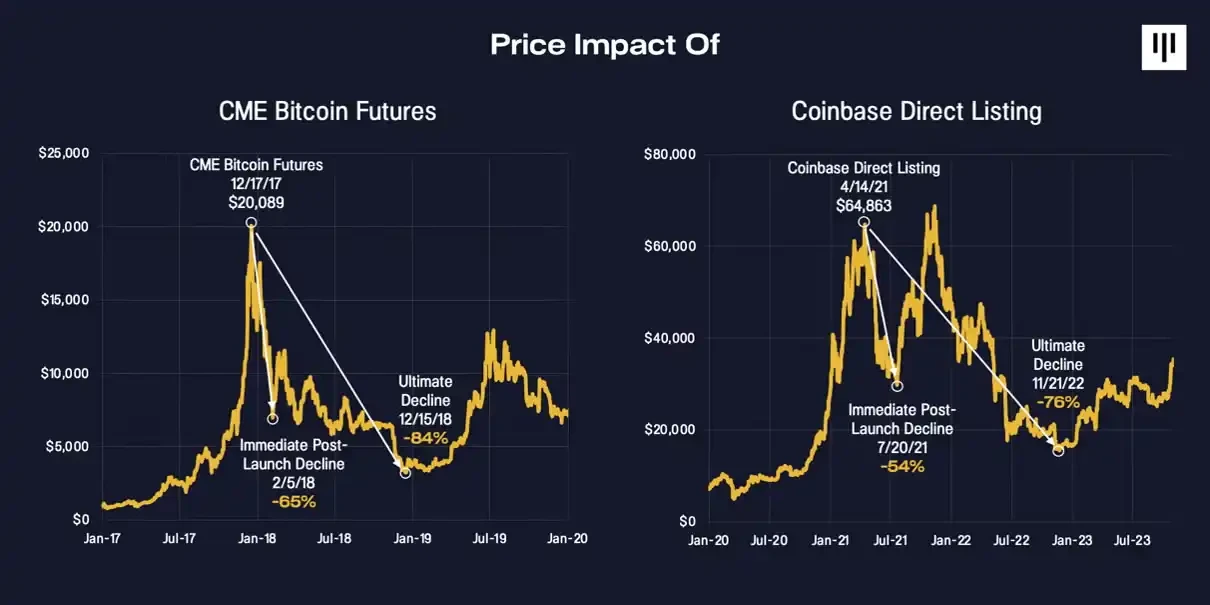
Bitcoin is up 103% since the launch of the Bitcoin ETF.
BlackRock’s Bitcoin ETF surpassed its 20-year-old gold ETF to become the ETF with more total assets in just eleven months. It broke records and was hailed as the “greatest launch in ETF history” when it surpassed $50 billion in assets, five times faster than the next ETF to reach that milestone.
I wish you all the best in 2025!
This article is sourced from the internet: Pantera 2025 Outlook: How will the on-chainization of the US dollar reshape the global financial landscape?
Related: Attention asset protocol Moongate officially launches native token MGT
Recently, Moongate officially launched its native token MGT, marking a major breakthrough in the project’s mission to “reshape the relationship between brands and consumers and redefine the value of user attention.” As an attention asset protocol activated for the real world, since its launch in 2022, the Moongate protocol has been actively used by more than 3,800 brands and creators including well-known brands such as Binance, OKX, Token 2049, EthDenver, Animoca, Wonderfruit, ComplexCon and Sony. It has enabled thousands of brands to launch smart token marketing campaigns and attracted the participation of more than 1.7 million C-end users. As the digital world continues to develop, the MGT token will introduce a structured incentive model for brands and consumers. It is worth mentioning that MGT is designed to support real-world brand…







